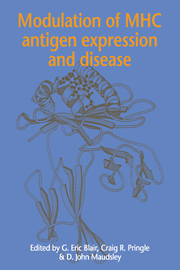Book contents
- Frontmatter
- Contents
- List of contributors
- Preface
- List of abbreviations
- 1 General introduction to the MHC
- 2 Organization of the MHC
- 3 Interactions of cytokines in the regulation of MHC class I and class II antigen expression
- 4 Control of MHC class I gene expression
- 5 Control of MHC class II gene expression
- 6 Modulation of MHC antigen expression by viruses
- 7 Modulation of MHC antigen expression by retroviruses
- 8 Modulation of MHC class I antigen expression in adenovirus infection and transformation
- 9 MHC expression in HPV-associated cervical cancer
- 10 Inhibition of the cellular response to interferon by hepatitis B virus polymerase
- 11 Cellular adhesion molecules and MHC antigens in cells infected with Epstein-Barr virus: implications for immune recognition
- 12 Effect of human cytomegalovirus infection on the expression of MHC class I antigens and adhesion molecules: potential role in immune evasion and immunopathology
- 13 Oncogenes and MHC class I expression
- 14 Mechanisms of tumour cell killing and the role of MHC antigens in experimental model systems
- 15 Manipulation of MHC antigens by gene transfection and cytokine stimulation: a possible approach for pre-selection of suitable patients for cytokine therapy
- 16 Overexpression of MHC proteins in pancreatic islets: a link between cytokines, viruses, the breach of tolerance and insulindependent diabetes mellitus?
- 17 The role of cytokines in contributing to MHC antigen expression in rheumatoid arthritis
- 18 Expression of an MHC antigen in the central nervous system: an animal model for demyelinating diseases
- Index
16 - Overexpression of MHC proteins in pancreatic islets: a link between cytokines, viruses, the breach of tolerance and insulindependent diabetes mellitus?
Published online by Cambridge University Press: 11 September 2009
- Frontmatter
- Contents
- List of contributors
- Preface
- List of abbreviations
- 1 General introduction to the MHC
- 2 Organization of the MHC
- 3 Interactions of cytokines in the regulation of MHC class I and class II antigen expression
- 4 Control of MHC class I gene expression
- 5 Control of MHC class II gene expression
- 6 Modulation of MHC antigen expression by viruses
- 7 Modulation of MHC antigen expression by retroviruses
- 8 Modulation of MHC class I antigen expression in adenovirus infection and transformation
- 9 MHC expression in HPV-associated cervical cancer
- 10 Inhibition of the cellular response to interferon by hepatitis B virus polymerase
- 11 Cellular adhesion molecules and MHC antigens in cells infected with Epstein-Barr virus: implications for immune recognition
- 12 Effect of human cytomegalovirus infection on the expression of MHC class I antigens and adhesion molecules: potential role in immune evasion and immunopathology
- 13 Oncogenes and MHC class I expression
- 14 Mechanisms of tumour cell killing and the role of MHC antigens in experimental model systems
- 15 Manipulation of MHC antigens by gene transfection and cytokine stimulation: a possible approach for pre-selection of suitable patients for cytokine therapy
- 16 Overexpression of MHC proteins in pancreatic islets: a link between cytokines, viruses, the breach of tolerance and insulindependent diabetes mellitus?
- 17 The role of cytokines in contributing to MHC antigen expression in rheumatoid arthritis
- 18 Expression of an MHC antigen in the central nervous system: an animal model for demyelinating diseases
- Index
Summary
Introduction
The expression of MHC products by pancreatic islet cells has been extensively studied because these cells are the targets of the destructive autoimmune response that leads to insulin-dependent diabetes mellitus (IDDM) and also because they constitute a set of distinct cell populations ideal for the study of peripheral tolerance by gene targeting in transgenic (tg) mice. Many of the studies described in this chapter were first prompted by concepts previously proposed in the aberrant class II expression hypothesis of endocrine autoimmunity (Bottazzo et al., 1983).
The aberrant class II expression hypothesis of endocrine autoimmunity
Aberrant (actually ectopic) HLA class II expression, i.e. the expression of HLA class II by cells of lineages that are normally class II negative, was first detected in the thyroid follicular cells of glands resected from patients suffering from autoimmune thyrotoxicosis, or Graves' disease (Hanafusa et al., 1983). This finding, together with the demonstration that thyroid follicular cells can be induced to express HLA class II antigens in vitro (Pujol-Borrell et al., 1983), led to the formulation of the aberrant class II expression hypothesis. This is based on the assumption that the lack of active immune response to endocrine cells and other scarce and differentiated cells present in peripheral tissues is the result of their low expression of HLA proteins, which makes them ‘invisible’ to T cells (immunological silence).
- Type
- Chapter
- Information
- Modulation of MHC Antigen Expression and Disease , pp. 361 - 389Publisher: Cambridge University PressPrint publication year: 1995
- 2
- Cited by



